Affirmation
by ANN Managing Editor Rob Finfrock
(My apologies to everyone who was expecting this installment
on Monday... when I'd originally planned for it to run. Alas, as
the days grow nearer to Oshkosh, time here at ANN is a precious
commodity... and there simply wasn't enough of it for me to
complete this story in time for Monday. From here on out, the
remaining installments in this series will run weekly, every
Thursday -- RJF)
"Clear skies, check... flight plan filed, check... sectional
charts, check... pilot, well..."
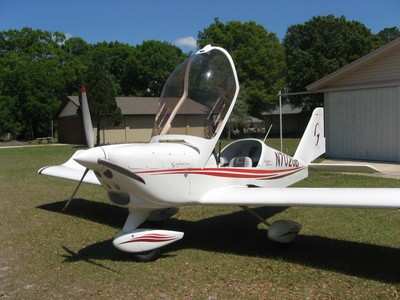
My heart was in my throat as I walked out to N702GB the morning
of April 2. My instructor, Jim Crone, had already pulled the plane
out, and he'd told me as I held on the phone with FSS that he'd
preflight the plane. Nevertheless, I now found myself retracing his
steps; couldn't be too careful, given the mission I was about to
undertake.
"Get a hold of Flight Service?" Jim asked me, as I stowed my
kneeboard in the left-side pocket, and moved to check the port-side
flap assembly.
I nodded; I'd actually gotten through to a briefer right away, a
friendly woman who was eager to walk me through the steps of filing
a flight plan. "And remember -- have fun!" she'd told me before
hanging up.
Jim grinned. "Great! Let me look over your flight plan."
I watched out the corner of my eye as Jim looked over the route
I'd picked out, and checked the times I'd computed. The route was
the exact one I'd plotted weeks before, sitting at my computer in
my home office in Albuquerque: Haller Airpark (7FL4) to Palakta
(28J), to Flagler County (XFL), and back to Haller. Jim had
initially said to expect a different route, just to shake things up
a bit... but after our trip down to Punta Gorda and back, he agreed
I'd handled enough curveballs when it came to cross-country
flying.
Of course, all that had been with Jim onboard. With my preflight
check complete, I turned my attention back to the task ahead of me
-- a solo cross-country.
*****
After my solo flight from Palatka the
day before, I'd had one more opportunity to fly the
Gobosh by myself. After taking my boss up for a quick checkout
flight, Jim Crone had encouraged me to take the Gobosh out by
myself Tuesday evening. "You have about 45 minutes of daylight
left, and plenty of fuel," he told me, after he and Jim Campbell
had landed back at Haller. "Go up, stay around the area and build
some time."
I distinctly remember gulping. My watch said 7:15 pm; the sun
hadn't set yet, but it was fairly close to entering "evening civil
twilight." And though I'd soloed the plane just hours before, I'd
never taken off by myself from Haller's 2,600' grass strip.
Still, I knew there was a difference between nervousness --
which I was certainly feeling -- and honest doubt about my
abilities, which I can safely say I had no real reservations about.
I jumped into the Gobosh's cockpit, ran through the preflight
checks, and soon was announcing my takeoff.
"Haller traffic, Light Sport seven-zero-two-golf-bravo taking
off runway 18, south departure, Haller." Just like I'd been taught,
I applied just enough throttle to get on the runway, holding full
back elevator to keep the nosewheel light on the grass. I then
smoothly applied full throttle, giving the rudder time to take hold
of the air coming off the prop to keep the plane straight. The
result was a near-perfect takeoff.
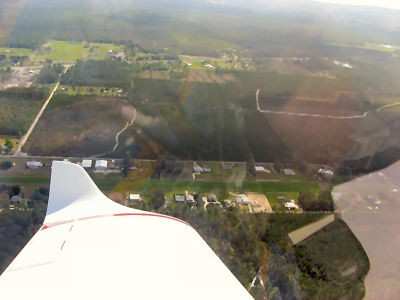
OK, Finfrock... if you can do that, you're good to go,
I thought to myself as I climbed through 500' AGL, retracting the
flaps. It never fails: my first 15 minutes in the air always
feel most foreign to me, as my body and mind reorient
themselves from ground-based references and sensations, to those of
being in the air. It also never fails that my left leg shakes
during this time; I've tried before to suppress the reaction, but I
long ago gave up trying to stop it. It usually stops my itself once
I level off.
 As it did this time. At
3,000 feet, I turned eastward to fly over the river... keeping an
eye out for the CBP P-3 Orions that often flew up the river at
around this time of day. It was a beautiful evening, and I could
see for miles in all directions; there was no sign of the big, grey
behemoths.
As it did this time. At
3,000 feet, I turned eastward to fly over the river... keeping an
eye out for the CBP P-3 Orions that often flew up the river at
around this time of day. It was a beautiful evening, and I could
see for miles in all directions; there was no sign of the big, grey
behemoths.
I pulled the throttle back to high-speed cruise, and trimmed for
level flight. With those tasks done, I relaxed ever-so-slightly...
then realized I really had no real gameplan for this flight, apart
from "go up, fly around a bit, and land." What to do, what to
do...
I opted to turn back across the river, now heading west, and
aimed for a spot about five miles southwest of Haller. Once in my
self-designated practice area, I made two clearing turns, scanning
for traffic... figuring I'd see at least someone also taking
advantage of the calm, clear night. Apart from lights from one lone
airliner, however, thousands of feet above me on a path towards
JAX... there was not a soul in sight.
It had a calming effect on me... to feel so alone in the
sky.
I picked my spot on the horizon, took one last look around for
traffic... then put the Gobosh into a left 45-degree turn, in an
attempt to nail the maneuver that had eluded me earlier that day.
Working the throttle, stick, and rudder, I held my altitude as I
came around the point... everything feeling much more on-target
than it had before. I rolled out to within five degrees of my
original heading -- more like three degrees, actually -- on
altitude. Taking but a split-second to mentally pat myself on the
back, I then rolled into a right turn... figuring this would be my
undoing, as it had been before.
It wasn't. My altitude deviated only slightly more than it had
during my left turn... but well within the 100-foot buffer zone.
And this time, I rolled out exactly on heading, my nose pointed
towards a set of stacks off to the northeast.
I looked at my watch. I'd been up for about 20 minutes by now,
and the sun was but a narrow slit of bright light on the horizon.
Time to head back to Haller... I thought, but then
stopped. But before you do that, time to banish another
demon.
As I've said earlier this series, I've never been comfortable
with stalls. I can perform them, and (more importantly) I recognize
the warning signs most planes give before entering a full
stall.
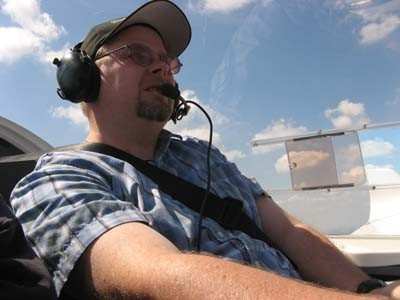
You can probably guess what I'm going to say next: I'd never,
ever performed a stall by myself. Time to change that, I
decided. No time like the present.
I felt "on" my game -- it was a great night, it had already been
a great flight, and I knew I'd feel that much more confident at the
controls if I could tell myself I had finally performed a solo
stall. Another quick scan of the area showed no other traffic
around for miles, same as before.
I was still at 3,000 feet, about 2,500 feet above the ground. I
pulled the throttle back, and trimmed for 60 knots in slow
flight... putting out the first notch of flaps, then the
second.
Rudder, rudder... I chanted to myself as I pulled the
throttle to idle, and slowly brought the nose back. I took a quick
glance at the airspeed indicator as the stall horn began to wail,
and I felt the first signs of buffeting: about 45 knots, give or
take. The nose held the its attitude, refusing to dip.
The buffeting grew stronger as airspeed continued bleeding
off... until the nose faltered ever-so-slightly, and the plane's
right wing dipped slightly, right on cue. I relaxed back pressure
and applied full throttle, using left rudder to bring the wings
level. I looked at the altimeter: holding steady at 2,800 feet. I'd
only lost 200 feet of altitude.
Once I had the plane cleaned up, I allowed myself a triumphant
fist-pump -- being careful not to strike the canopy. "Yeah!" I
exclaimed to no one but myself. "Good little plane!" I said,
patting the IP combing. "Good little Gobosh!"
About 10 minutes later, I was back on the ground at Haller. My
landing had been entirely uneventful, but for the fact it was
completely smooth... and, completely my own. Both Jims greeted me
after I shut down the engine.
"Nice landing, Bubba," Jim Campbell told me. "I'd be happy claim
that landing, and your takeoff, as my own." I took that as a high
compliment.
*****
"Are you sure this number is right?" Jim Crone was now asking
me, regarding my flight plan. He pointed to my on-course heading
for the leg between Palatka and Flagler County.
I raised my eyebrow, but then nodded vigorously. "Yes," I
replied. "See? My wind angle is here, and this is my corrected
course heading."

Jim studied the numbers, then smiled. "Yep, you're right," he
told me. "Looks like you're ready to go!"
My instructor helped me pull the plane across the road to the
taxiway -- neither he nor I had worked up the courage to taxi the
Gobosh across the gravel road -- and then Jim shook my hand. "See
you in a few hours," he told me. "And have fun!"
I felt those nerves again as I climbed into the cockpit, and
laid out my flight plan in the unoccupied passenger seat. I asked
myself the same question I'd asked myself the evening before --
nerves, or doubt? -- and I received the same answer. I was
nervous... but confident in my abilities, too.

I caught sight of Jim Crone as I taxied out. He was walking
along the side of the strip, positioning to catch my takeoff
rotation. Don't look at him, I instinctively told myself
as I turned onto the runway after completing my pre-takeoff checks.
You won't hit him so long as your takeoff is straight.
It was (and Jim did a nice job of capturing my rotation and
climbout.) With my left leg shaking, I climbed out on a straight
course to the south, en route to my first stop at Palatka.
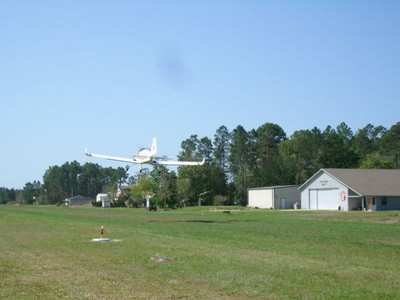
After climbing to 3,000 feet, I attempted to contact Flight
Watch out of Jacksonville to activate my flight plan. No joy... and
I was reluctant to climb much higher, since I was already close to
halfway to 28J. Hmmm... first duty, fly the plane, I
thought, figuring I'd solve that particular issue on the
ground.
At about seven miles out, I called for advisories. The radio
indicated two other planes in the pattern at Palatka: one on left
downwind for runway 27, the other just taking off. Once I was down
to pattern altitude, I caught sight of the second plane, which by
now was turning onto downwind. The first plane was just turning
from base onto final.
Decision time. I was tracking for an entry into the pattern on
the upwind leg. I was already at pattern altitude; if I chose to
overfly the airport and enter on a 45 onto downwind, I'd have to
climb. It wasn't optimal, but the spacing was such I could enter on
crosswind without any conflict. Or, you can do it right and fly
the full pattern, I chided myself.
"Palatka/Kay Larkin traffic," I announced, "Light sport
seven-oh-two-golf-bravo two miles to the north, will enter midfield
on the left upwind for runway 27, Palatka."
"Cessna XXX, on short final for 27, full stop, Kay Larkin," the
first plane radioed. Even better. By the time I entered
the upwind leg, the first plane was already rolling off the runway,
with the second just turning base.
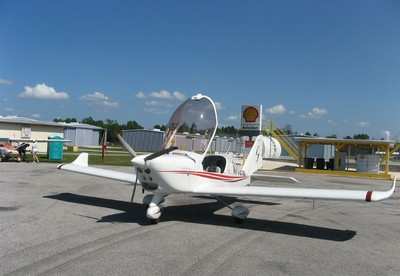
"Poyfect," I said. No conflict. I was on downwind by the time
the second plane was off the runway again; I hadn't understood the
type during that pilot's radio calls (due to its proximity to
Embry-Riddle and CAPT, this area of Florida sees many
student pilots from foreign, non-English-speaking
lands) but from my vantage point it looked like a Cirrus.
Once abeam the numbers, I slowed the Gobosh down from 70 knots
to 60, and applied the first setting of flaps. The nose lowered
obediently, and gave me a steady descent rate of 500 fpm.
There was only a slight crosswind from the left as I turned
final... but it died as I crossed the threshold. There was no
sign of wind at all as I flared, with the mains lightly touching
down on the runway. "I wish someone could have gotten a picture of
that," I muttered to myself as the nosewheel came down, and I
rolled out.
As it turns out, no one had snapped a photo of my landing... but
someone did take my picture as I taxied past the FBO, and over to
the fuel pumps.
After topping off the Gobosh's 18.5 gallon fuel tank, I pulled
the plane over to a vacant parking spot (gotta love lightweight
planes!) and walked towards the FBO to have my logbook
signed.
Two men were stood by the door talking as I approached. One of
them was Hernan Enriquez, a recreational plane spotter
who asked me several questions about N702GB. By now, I
was used to feeling like a minor celebrity flying the Gobosh. With
less than twenty 700S aircraft in the United States so far,
few people have ever seen one... and both Jim and I had
grown accustomed to answering questions at every airport we'd
stopped at.
Though I had a schedule to keep, I spent a few minutes chatting
with Hernan. "It's made in Poland, distributed by a company in the
Midwest," I told him. "Flies a little like a 3/5-scale Piper
Warrior." (My gracious thanks to Hernan for allowing me to post
his photo of me, below.)
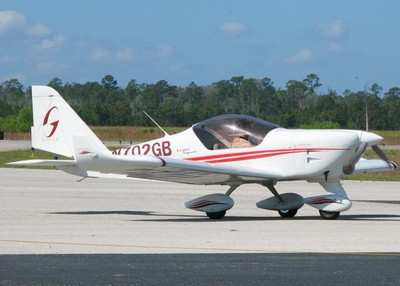
After grabbing a bottled water and getting my logbook stamped by
Donna, the airport manager, I walked back across the ramp towards
2GB... then remembered I hadn't been able to contact Flight Watch.
Instead, I called Flight Service on my cell phone, and told the
briefer to activate my flight plan, effective 20 minutes ago. I
also checked to make sure I had called the right frequency in the
air; I had, but apparently I'd been too low to reach them.
Back in the cockpit, I looked over my flight plan. Now, I was
entering uncharted territory, so to speak. I'd flown to Palatka
dozens of times in the past week, and I knew the route by heart...
but this would be the first time I'd ever flown to Flagler County,
period. I wanted to make sure I had my ducks in a row.
Confident I was as prepared as I could be, I fired up the engine
and taxied out for departure. My takeoff was uneventful; I realized
on climbout that somewhere along the line, smooth takeoffs had
become the norm... not the exception. When did that
happen? I mused.
I climbed out of the pattern on downwind. After leveling off at
2,500 feet, I turned southeast towards Flagler County... or, in the
rough direction where I knew Flagler County to be. A low haze
obscured much of the coastline, though I could still make out where
the beach met the ocean.
At about 15 miles out from XFL (according to both my flight
plan, and the GPS) I tuned the radio to the Flagler CTAF. The
frequency was a cacophony of radio calls; I counted at least four
different N numbers, all swarming around the pattern at various
points. I gulped a little. I was about to enter a very busy
hive.
As I got closer, however, a funny thing happened. My mental
picture of the pattern started falling into place: that
plane is on downwind, one plane is ahead of it turning base, a
third just took off... It also helped I could now see the
airfield -- I was 10 miles out at this point -- and I
could even see one of the planes in the pattern.
I made my first, tentative radio call. "Flagler County traffic,
Light Sport 702GB 10 miles to the west, landing Flagler." My call
was immediately greeted by two other quick calls, one right after
another, both aircraft announcing their positions and paying me
little heed.

Well, this was going to be interesting, I thought. I
initially figured I would fly a bit south of the field, to enter
the downwind leg for the active runway, 29... but as I drew closer,
I realized this approach may cause more problems than it was worth.
At about three miles out, I saw two other planes approaching the
field from the south, both high-wing Cessnas, also entering on the
45.
I realized I could enter directly on the downwind, and slot in
behind those two planes with no fuss, no muss. I would also be
safely ahead of the traffic that had just landed on the runway.
"Flagler County traffic, Light Sport two-golf-bravo two miles to
the west, will be entering on the left downwind for 29 behind
traffic in sight on the 45, Flagler." I knew I rushed through the
call, and it was a bit non-standard... but it also conveyed all the
information that was needed at this point.
My decision was soon affirmed. "Flagler County, Twin Star XXX on
upwind, have the light sport in sight, Flagler." I caught sight of
the sleek twin -- as cool as DA42s look on the ground, they look
fantastic in the air -- abeam my wing as I slotted onto downwind,
with another plane behind it just taking off. By this time, the
second plane I'd seen on the 45 was safely ahead of me, at roughly
midfield.
Words cannot sufficiently express what came next... the smooth,
mechanical precision and artistry of a congested traffic pattern
flown properly. Even as I scanned for traffic and readied the
Gobosh for landing, I marvelled at the scene playing out before me,
of which I was also an integral part.
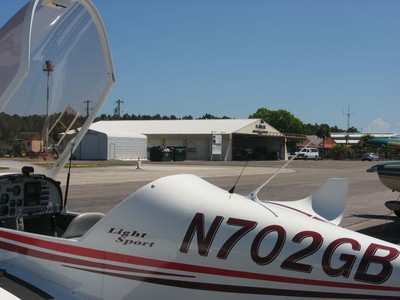
I usually scoff at the concept of a collective mind... of
several people working towards a common goal, with only the
faintest communication (or none at all) between them. But, well...
I was now seeing exactly that unfold. Even more importantly, the
pilots around me were relying on me, student pilot or no, to do my
part in that process.
I'm proud to say that I did. I turned base once abeam of the
Cessna ahead of me on final, which in turn was off the runway well
before I crossed the numbers. "Flagler traffic, light sport
two-golf-bravo, short final 29, full stop, Flagler." My landing
wasn't as spot-on as the one back at Palatka had been -- I flared
properly, but landed a hair right of centerline -- but that didn't
matter as much to me as the fact I was clear of the runway well
before the Twin Star crossed the threshold.
No one would need to go-around because of ME today!
My taxi to the ramp was complicated a bit by construction off
the runway... but soon I had parked 2GB and shut down, right next
to a nice older-model SR22. I literally leapt out of the cockpit...
and, yes, it was time for another fist-pump. I did it! I'd landed
at an airport I'd never been to... and it hadn't been the easiest
task, either!
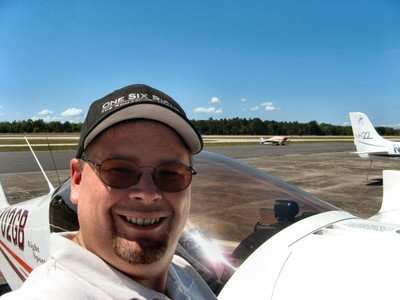
I nearly skipped into the FBO, and walked proudly over to the
counter person to sign my logbook... feeling more like a pilot than
I ever had before.
*****
About 20 minutes later, I was back in the air, heading "home" to
Haller. I was the last plane to take off before the traffic pattern
switched to 11; the wind had shifted in the time I'd been on the
ground, which meant I took off with a slight tailwind... hardly a
factor, though, given the Gobosh's short-field capabilities and the
5,000-foot runway at Flagler.
Truth be known... I don't remember very much about the flight
home. Few specifics, anyway; I recall gazing at the Atlantic Ocean,
marveling how it looked from 3,000 feet. (My camera was stowed in
the bin behind me -- I'd resolved before starting out I wouldn't
take any photos in-flight, so I could remain completely focused on
the task of flying -- and yes, I now regretted that decision.) I
also remember watching a thin ribbon of black smoke rise from the
ground below, well off my right wing, evidence of a small brush
fire.
Mostly, though... what I remember is an amazing sense of
well-being, and contentment. Don't misunderstand -- I was still
busy, scanning for traffic and keeping the plane at 2,500 feet in
the somewhat choppy air of noon time over Florida. I certainly
hadn't "slacked off"... but I do admit at one point to stretching
my arm over the top of the right seat, with just the fingertips of
my left hand on the control stick, and saying a quick prayer of
thanks.
"All the grief of the past few years..." I began quietly. "All
the fear, all the stress and worry. The checks, the scans, the
uneasiness that never, ever completely disappears... I have to say,
at this moment... well, it's all been worth it."
At that moment, the cockpit of this tiny light sport plane --
2,500 feet (give or take 50) over northern Florida -- became
nothing less than a cathedral for me. A Holy place, where I felt in
tune with the higher forces at work.
I think a lot of pilots would understand that.
*****
I have two stories to finish up with. The first I've alluded to
earlier in this series -- upon my safe (and, if I say so myself,
quite stunning) landing back at Haller, I realized my instructor
had already taken off for lunch.
I'll be honest -- the first few seconds after I realized no one
was there to greet me, to see me safely back from my brave journey
(there was also no one to help me pull the plane back across the
road) I felt a bit miffed.
But that soon dissolved into a smile... and soon, out-and-out
laughter. I had to admit, it was a great show of confidence -- the
fact my instructor hadn't felt like he had to wait for me, to
insure my safe return. Or maybe hunger had simply won out.
Here's the second story. Just as Jim had instructed me to do, my
first call after landing wasn't to him, or to my family. It was to
Flight Service, to close my flight plan.
By an odd twist of fate, I got the same briefer whom I'd filed
my flight plan with, nearly two-and-a-half hours before. Once I
gave her my tail number, her voice seemed to light up.
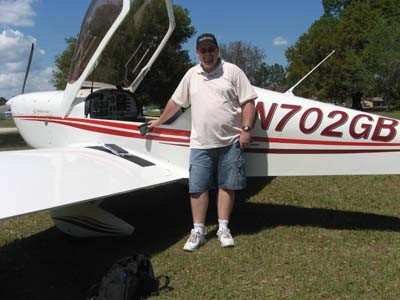
"So, did you have fun, Mr. Pilot?" she asked me.
Coming Next Week: Time To Meet The Examiner
 ANN's Daily Aero-Linx (04.16.24)
ANN's Daily Aero-Linx (04.16.24) Aero-News: Quote of the Day (04.16.24)
Aero-News: Quote of the Day (04.16.24) Airborne 04.10.24: SnF24!, A50 Heritage Reveal, HeliCycle!, Montaer MC-01
Airborne 04.10.24: SnF24!, A50 Heritage Reveal, HeliCycle!, Montaer MC-01 Airborne 04.12.24: SnF24!, G100UL Is Here, Holy Micro, Plane Tags
Airborne 04.12.24: SnF24!, G100UL Is Here, Holy Micro, Plane Tags Airborne-Flight Training 04.17.24: Feds Need Controllers, Spirit Delay, Redbird
Airborne-Flight Training 04.17.24: Feds Need Controllers, Spirit Delay, Redbird















